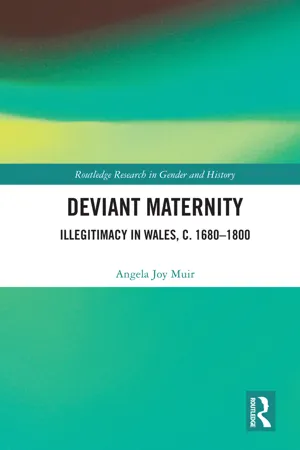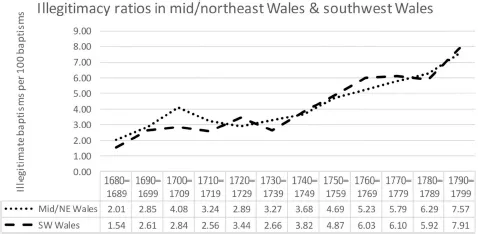
This is a test
- 262 pages
- English
- ePUB (mobile friendly)
- Available on iOS & Android
eBook - ePub
Book details
Book preview
Table of contents
Citations
About This Book
This is the first-ever book to explore illegitimacy in Wales during the eighteenth century. Drawing on previously overlooked archival sources, it examines the scope and context of Welsh illegitimacy, and the link between illegitimacy, courtship and economic precarity. It also goes beyond courtship to consider the different identities and relationships of the mothers and fathers of illegitimate children in Wales, and the lived experience of conception, pregnancy and childbirth for unmarried mothers. This book reframes the study of illegitimacy by combining demographic, social and cultural history approaches to emphasise the diversity of experiences, contexts and consequences.
Frequently asked questions
At the moment all of our mobile-responsive ePub books are available to download via the app. Most of our PDFs are also available to download and we're working on making the final remaining ones downloadable now. Learn more here.
Both plans give you full access to the library and all of Perlego’s features. The only differences are the price and subscription period: With the annual plan you’ll save around 30% compared to 12 months on the monthly plan.
We are an online textbook subscription service, where you can get access to an entire online library for less than the price of a single book per month. With over 1 million books across 1000+ topics, we’ve got you covered! Learn more here.
Look out for the read-aloud symbol on your next book to see if you can listen to it. The read-aloud tool reads text aloud for you, highlighting the text as it is being read. You can pause it, speed it up and slow it down. Learn more here.
Yes, you can access Deviant Maternity by Angela Joy Muir in PDF and/or ePUB format, as well as other popular books in History & British History. We have over one million books available in our catalogue for you to explore.
Part I
Prevalence and Causes
1 Illegitimacy, Paternity, Courtship and Poverty1
This chapter examines in detail the illegitimacy ratios from the 45 study parishes in mid and northeast Wales.2 Quantitative analysis of illegitimacy ratios demonstrates that Welsh patterns of illegitimacy did roughly resemble trends elsewhere in Britain, but they differed in significant ways. Two important patterns emerge from this data: levels of illegitimacy were much higher in certain, but not all, parts of Wales in the eighteenth century, and levels of identified illegitimate paternity were consistently high in some regions, and fell considerably in others. As one of the first large-scale studies of Welsh data it is important to consider this evidence in relation to some of the extensive research on illegitimacy in England. For the purposes here, Welsh data is considered against two explanatory frameworks: those which attribute rising levels to cultural changes that influenced premarital sexual behaviour, and those which associate increases in illegitimacy with economic opportunities created by industrialisation.3 The data presented here were considered in relation to other potential influencing factors, such as parish-level sex ratios, language and geographic features such as elevation; however no meaningful patterns or correlations emerged.4 The two explanatory frameworks used in the analysis that follows have been chosen because they relate to significant cultural and socioeconomic changes that, in many ways, defined Britain in the eighteenth century.
Welsh evidence appears to challenge these understandings: because Wales was linguistically different and lacked certain cultural markers which some historians have associated with an eighteenth-century ‘sexual revolution’ And, furthermore, because the highest levels of illegitimacy are found in agricultural regions of Wales which experienced little or no industrial change. What the evidence examined here indicates is that Welsh illegitimacy was influenced by a combination of courtship-led marriage customs, a decline in traditional forms of social control and worsening economic circumstances. Surprisingly, these patterns appear remarkably similar to those found in London during the same period. Central to understanding these patterns are the cultural and economic contexts within which these changes occurred.
One of the biggest questions that historians of illegitimacy have tried to answer is why so many unmarried women bore children outside wedlock, particurarly towards the end of the eighteenth century. Hypotheses have included Laslett’s ‘bastardy prone sub-society’, theories which relate either to non-marital cohabitation and irregular marriage, conjugal courtship customs whereby intended marriages were either delayed or thwarted as a result of changing socioeconomic circumstances and changes in sexual practice resulting from shifting attitudes towards penetrative sex.5 Theories related to the bastardy prone sub-society, cohabitation and irregular marriage will be explored in Chapter 2. For the purposes of this chapter, Welsh evidence will be considered in relation to changes in sexual practice, and to theories about socioeconomic influences on courtship. Historians such as Tim Hitchcock, Thomas Laqueur, Randolph Trumbach and Faramerz Dabhoiwala have argued that the types of heterosexual sexual activity men and women engaged in changed during the eighteenth century, displacing activities such as mutual masturbation with penetrative sex, which resulted in more children being conceived and born outside of marriage.6 Other historians, such as Peter Laslett, Richard Adair, Thomas Nutt and Nicholas Rogers have utilised various demographic, social and economic approaches to parish and court records to account for rising levels of illegitimacy.7 Central to these approaches is the understanding that most illegitimacy resulted from courtships in which couples engaged in penetrative sex with the intention (or at least promise) of marriage, but failed to marry when pregnancy occured.8 Such failures are often attributed to economic circumstances which prevented couples from marrying, and thus the influence of industrialisation in the eighteenth century is often central to these discussions.9
These two broad explanatory frameworks are not entirely at odds with each other, and do help shed light on different aspects of the tremendously complex phenomenon of plebeian sexual culture in the eighteenth century, which is notoriously difficult to access. It is therefore useful to consider these in tandem.10 The extensive work which has been done within these broad approaches is compelling and convincing, and contributes a great deal to our understanding of illegitimacy in eighteenth-century England. Both Emma Griffin and Adrian Wilson have integrated elements of these two broad approaches to explore the ways in which sexual practice intersected with changing economic circumstances to produce a larger number of illegitimate children in the eighteenth century.11 These integrated approaches provide a useful starting point for analysis of Welsh illegitiamcy, and also allow for the Welsh context to be drawn into the debates about illegitimacy in Britain more broadly. Levels of illegitimacy will be analysed first, followed by an examination of patterns of identified illegitimate paternity. The significance of these demographic trends will then be considered in relation to sexual culture and courtship in Wales, and an examination of economic circumstances within which these activities took place. What this analysis reveals is the extent to which illegitimacy levels were acutely sensitive to economic hardship, the effects of which were amplified when certain types of courtship practices were present.
Comparative Illegitimacy Ratios
Figure 1.1 compares the aggregate data from the 45 Welsh parishes to Laslett’s 98 English parishes.12 This comparison indicates that levels of reported illegitimacy in Wales during the eighteenth century were consistently, and at times significantly, higher than the overall average for England. The illegitimacy ratio in mid-Wales- rose 2 per cent to 7.5 per cent over the 120-year period, with one early peak of 4 per cent in the decade 1700–1709, dropping back to roughly 2.9 per cent in the 1720s before steadily increasing. This early peak may provide evidence that fluctuations in illegitimacy in Wales are attributable to less than favourable economic circumstances, as these years saw a series of poor harvests due to long winters and cold summers which resulted in famine, particularly in the celtic periphery of Britain.13 During this decade, Montgomeryshire experienced three years of ‘crisis mortality’ when the number of burials outnumbered the number of baptisms by at least 10 per cent. In 1709 crisis mortality in the county reached 20 per cent, and in 1700 and 1708 this rose to over 30 per cent.14 Other than the early peak, the trend in Wales appears to have followed roughly the same pattern as in England, with increasing divergence over the course of the period. In the 1680s the difference between Wales and England was approximately 0.5 per cent, whereas by the end of the eighteenth century it had increased to nearly 2.5 per cent.

Figure 1.1Comparison of illegitimacy ratios in Wales and England.
Source: English data taken from Laslett, ‘Introduction’, Bastardy, p. 14.
These findings are consistent with evidence presented by Anna Brueton in her doctoral research on south Wales. She found illegitimacy ratios in the regions she examined fluctuated in an increasing trend from just below 2 per cent in the 1680s to just below 8 per cent in the late 1790s (Figure 1.2).15 Illegitimacy in south Wales in the 1680s was comparable to the aggregate for England as a whole, however it increased steadily in the 1690s and 1700s and then dropped before reaching an early peak in the 1720s. The ratio then fell more markedly in the 1730s than it did in mid and northeast Wales, dropping slightly below the English average before continuing on a similar upward and increasingly divergent trend over the remaining decades of the century. The continuinity in trend between south, mid and northeast Wales is striking, particularly from the 1740s onwards. Based on Brueton’s findings and the data presented here, it is now possible to say with a sufficient degree of certainty that levels of recorded illegitimacy across Wales were noticeably on the increase from the second quarter of the eighteenth century onwards, and gained increased momentum as the century progressed. Although illegitimacy in England was also on the rise during this period, overall levels in Wales were consistently higher, and the marked differences noted by poor law reports in the 1830s were evident in some parts of Wales at least 100 years before this date.

Figure 1.2Comparison of illegitimacy in mid and northeast Wales with southwest Wales.
Source: Southwest Welsh data taken from Brueton, ‘Illegitimacy in South Wales’, p. 49.
Regional Trends
In his study of 250 English parishes between the 1530s and 1750s, Adair distinguished between highland regions in the north and west, and lowland regions in the south and east of England, and found that highland regions consistently experienced higher levels of illegitimacy throughout the period covered by his study.16 All of the Welsh parishes considered here are in Adair’s highland zone, so his highland/lowland distinction is not appropriate to this study. However, regional variations which may not be linked to topography are still evident. Comparisons can be made with Adair’s regional data for the latter part of the seventeenth and early eighteenth centuries. The most relevant regions for comparison are Adair’s west and northwest regions, as the western region includes the county of Shropshire, which borders Denbighsire, Montgomeryshire and Radnorshire, and the northwest region shows a roughly analogous pattern of change over time (see Figure 1.3).17 Althoug...
Table of contents
- Cover
- Half Title
- Series
- Title
- Copyright
- Dedication
- Contents
- List of Figures
- List of Tables
- Acknowledgments
- Introduction
- Part I Prevalence and Causes
- Part II The Mortality Penalty
- Part III The Experience of Pregnancy and Childbirth for Unmarried Mothers
- Bibliography
- Index